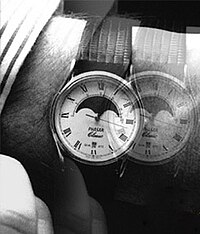
Photo from wikipedia
BACKGROUND Despite automated pupillometry's (AP) improved detection of relative afferent pupillary defects (RAPDs) compared with the Swinging Flashlight Test (SFT), AP remains uncommon in clinical practice. This study examined barriers… Click to show full abstract
BACKGROUND Despite automated pupillometry's (AP) improved detection of relative afferent pupillary defects (RAPDs) compared with the Swinging Flashlight Test (SFT), AP remains uncommon in clinical practice. This study examined barriers to routine use of AP in evaluation of acute vision loss. METHODS (1) Ophthalmologists and optometrists' perceptions of AP were captured via electronic survey. (2) Ophthalmologists were presented with clinical vignettes to assess their use of AP in clinical decision-making. (3) Patients presenting with decreased vision to an ophthalmology urgent care clinic underwent manual SFT and AP screening to evaluate ophthalmologists' perceptions of the device. RESULTS Surveys indicated that clinicians were "neutral" to "somewhat likely" to use AP. In clinical vignettes, more physicians proceeded with workup for optic nerve pathology when presented with an RAPD by AP than SFT (77% vs 26%, P = 0.003). When SFT and AP results were discordant, more physicians proceeded with workup for optic nerve disease when AP was positive and SFT was negative than vice versa (61% vs 18%, P = 0.008). In the clinical study of 21 patients, 50% of RAPDs detected by AP were not detected by SFT, although ophthalmologists rated AP's usefulness as only "neutral" to "somewhat useful." CONCLUSION Clinicians value pupillary examination and trust AP over SFT; however, widespread adoption and perceived value of AP may depend on its impact on clinical outcomes. Within a comprehensive diagnostic device, AP may be an important tool, but is not necessary to screen for optic nerve disease or evaluate acute vision loss.
Journal Title: Journal of Neuro-Ophthalmology
Year Published: 2020
Link to full text (if available)
Share on Social Media: Sign Up to like & get
recommendations!